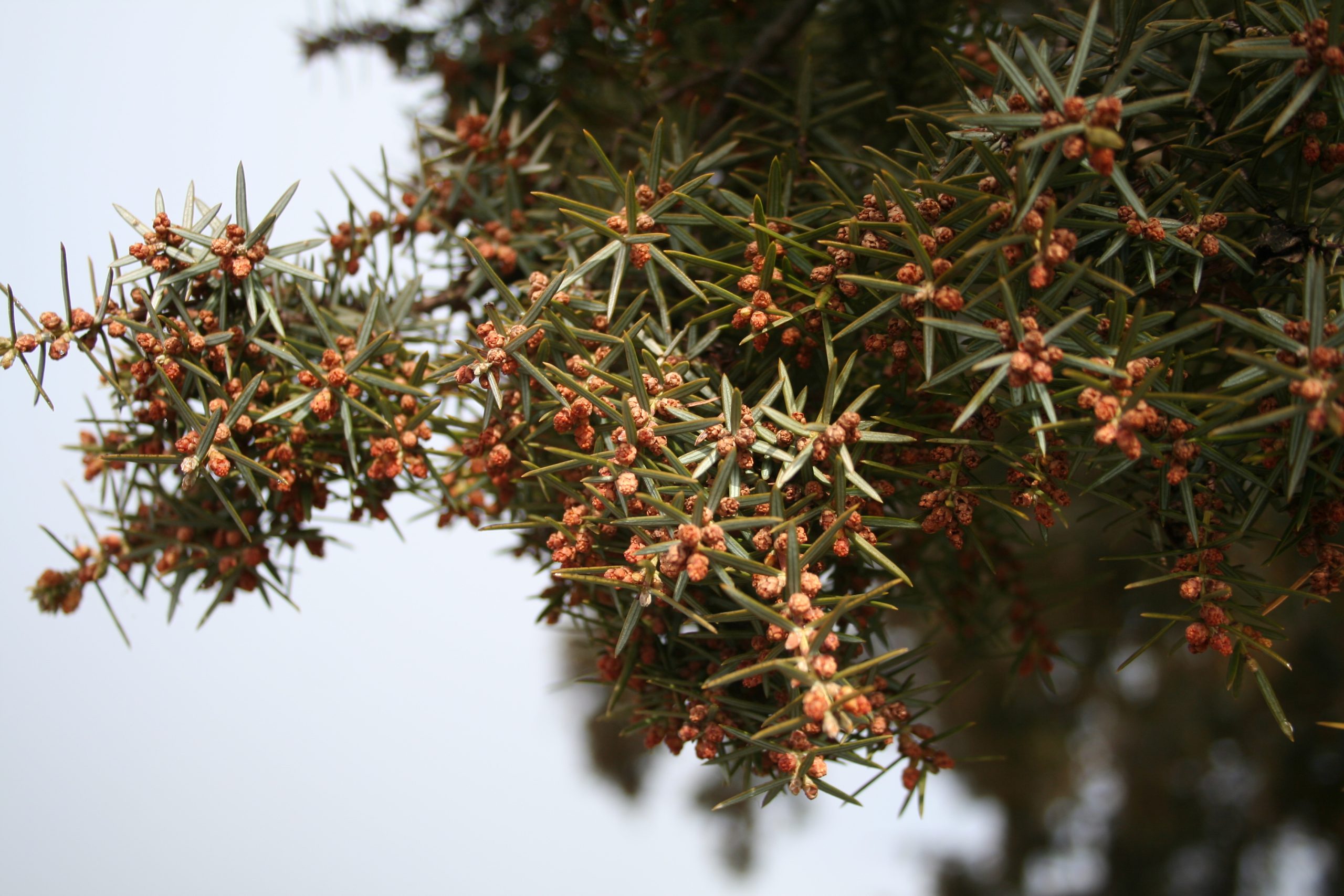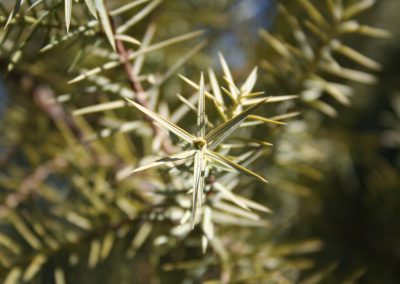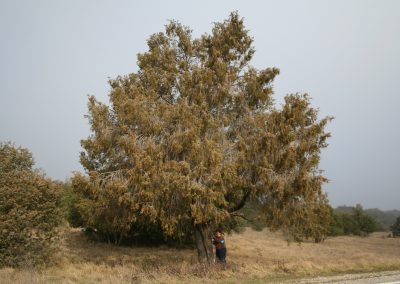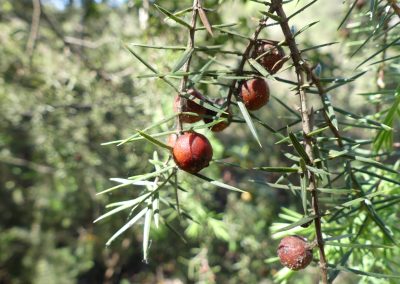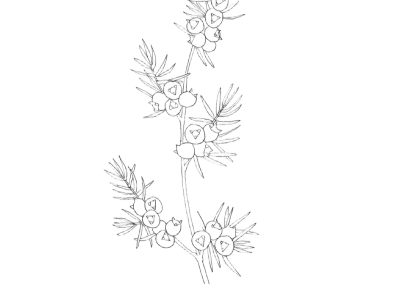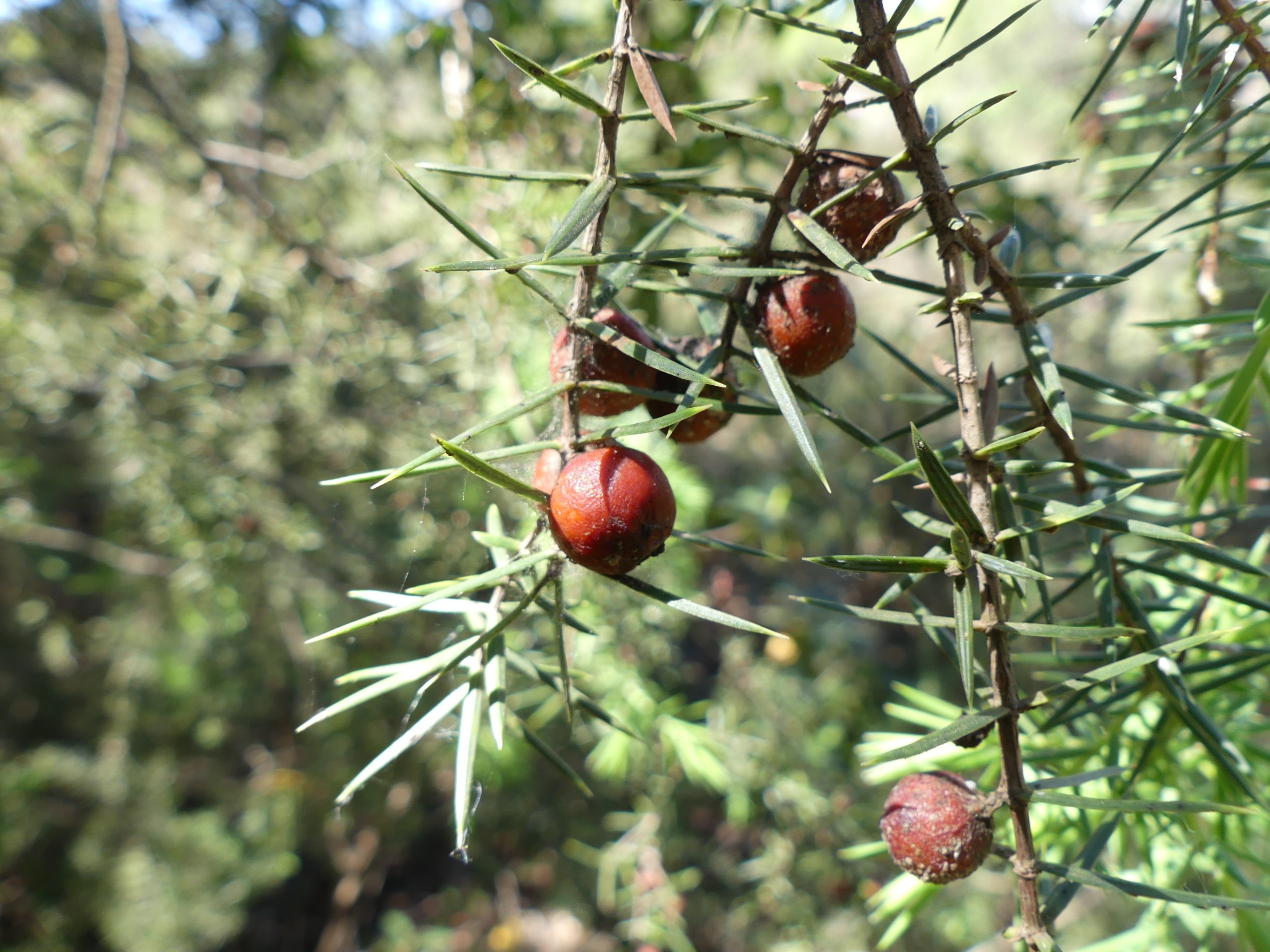Juniperus oxycedrus
Scientific description
Taxon: Juniperus oxycedrus
Class: Pinopsida (Conifers)
Subclass: Pinidae
Order: Pinales
Family: Cupressaceae
Common name: Cade juniper / Prickly juniper
Origin:
Mediterranean region, Southern Europe, North Africa.
Description:
Coniferous shrub or small tree 6–10 m tall. Evergreen foliage of sharp needles grouped in threes, dark green to bluish-green. Bark reddish-brown, thick, scaly. Fleshy cones (galbuli) green turning bluish-black; monoecious flowers in spring. Adapted to dry, rocky soils, common in Mediterranean scrublands and maquis.
Propagation:
Seeds dispersed by birds (slow germination), natural layering possible.
Ecology:
Pioneer species; drought, wind, poor soil resistant. Important for soil stabilization and biodiversity.
Uses:
Wood for charcoal and carpentry; essential oil (cade oil) for traditional medicinal and cosmetic use.
Threats:
Not globally threatened; some populations may be vulnerable to deforestation and repeated wildfires.
Taxon : Juniperus oxycedrus
Classe : Pinopsides (Conifères)
Sous-classe : Pinées
Ordre : Pinales
Famille : Cupressacées
Nom commun : Genévrier cade / Genévrier épineux
Origine :
Région méditerranéenne, Europe du Sud, Afrique du Nord.
Description :
Arbuste ou petit arbre conifère 6–10 m. Feuillage persistant en aiguilles piquantes par trois, vert foncé à bleu-vert. Écorce brun-rougeâtre, épaisse et écailleuse. Galbules verts puis bleu-noirs; fleurs mâles et femelles distinctes au printemps. Adapté aux sols secs et rocailleux; présent dans garrigues et maquis méditerranéens.
Propagation :
Graines dispersées par oiseaux (germination lente), marcottage naturel possible.
Écologie :
Espèce pionnière, résistante à la sécheresse, vent et sols pauvres. Stabilisation des sols et biodiversité locale.
Utilisation :
Bois pour charbon et menuiserie; huile essentielle (huile de cade) usage traditionnel médicinal et cosmétique.
Menace :
Non menacé globalement; certaines populations vulnérables à la déforestation et incendies répétés.
Taxon: Juniperus oxycedrus
Clasă: Pinopsida (Conifere)
Subclasă: Pinidae
Ordin: Pinales
Familie: Cupressaceae
Denumire populară: Ienupăr cade / Ienupăr spinos
Origine:
Regiunea mediteraneană, sudul Europei, nordul Africii.
Descriere:
Arbust sau arbore mic conifer 6–10 m înălțime. Frunziș persistent, ace ascuțite grupate câte trei, verde închis până la verde-albăstrui. Scoarță brun-roșiatică, groasă și solzoasă. Galbule verzi apoi albăstrui-negre; flori masculine și feminine separate primăvara. Adaptat la soluri uscate și pietroase, frecvent în garigă și maquis mediteranean.
Propagare:
Semințe răspândite de păsări (germinație lentă); marcotaj natural posibil.
Ecologie:
Specie pionieră, rezistentă la secetă, vânt și soluri sărace. Importantă pentru stabilizarea solurilor și biodiversitate.
Utilizare:
Lemn pentru cărbune și tâmplărie; ulei esențial (ulei de cade) pentru uz medicinal și cosmetic tradițional.
Amenințări:
Nu este amenințat global; unele populații pot fi vulnerabile la defrișări și incendii repetate.
Ταξινόμηση: Juniperus oxycedrus
Κλάση: Πινόψιδα (Κωνοφόρα)
Υποκλάση: Πινίδες
Τάξη: Pinales
Οικογένεια: Κυπαρισσίδες (Cupressaceae)
Κοινή ονομασία: Άρκευθος η οξυκέδρος / Αγκαθωτός άρκευθος
Προέλευση:
Μεσογειακή περιοχή, Νότια Ευρώπη, Βόρεια Αφρική.
Περιγραφή:
Κωνοφόρος θάμνος ή μικρό δέντρο 6–10 μ. Αειθαλές φύλλωμα με αιχμηρές βελόνες ανά τρία, σκούρο πράσινο έως γαλαζοπράσινο. Φλοιός καστανοκόκκινος, παχύς και φολιδωτός. Γάλβουλα πράσινα, ωριμάζουν σε μαυρομπλέ; μονοοϊκά άνθη την άνοιξη. Προσαρμοσμένος σε ξηρά, πετρώδη εδάφη, συχνά σε μακκία και φρυγανώδη τοπία.
Διάδοση:
Σπόροι διασπείρονται από πουλιά, βλάστηση αργή. Μπορεί να πολλαπλασιαστεί με φυσικό καταβολάδα.
Οικολογία:
Πρωτοπόρο είδος, ανθεκτικό στην ξηρασία, στον άνεμο και σε φτωχά εδάφη. Σημαντικό για σταθεροποίηση εδάφους και τοπική βιοποικιλότητα.
Χρήσεις:
Ξύλο για κάρβουνο και ξυλουργική. Αιθέριο έλαιο (έλαιο κάδερου) για παραδοσιακή φαρμακευτική και καλλυντική χρήση.
Απειλές:
Δεν απειλείται παγκοσμίως, αλλά ορισμένοι πληθυσμοί ευάλωτοι σε αποψίλωση και επαναλαμβανόμενες πυρκαγιές.
Creative writing inspired by Juniperus oxycedrus
Cade juniper
In a faraway valley, there lived a goat called Marie. Marie had a sweet tooth and generally liked to taste the fruits of various plants. She was particularly fond of plants with thorny foliage. One sunny morning, as she strolled along carefree, she spotted a tree with beautiful fruit. It was the famous juniper. Ready to taste them, she tasted the fruit and was disappointed, because she didn't like them at all.
She went to rest by the river, where she decided to sleep. When she wakes up, she sees a hungry little goat beside her, which seems to have lost its mother. Marie looks around for trees with fruit to feed the little goat, but finds nothing. Nor is there any grass in the field, only earth. Strange. All she can find are juniper berries. She has no choice but to take what she's picked for him. The little goat not only eats them, but seems to love them. Marie looks at it curiously and decides to try the plant again. She is delighted with the taste this time and sets off to find the same plant to pick the fruit for herself and the little goat.
The whole valley is filled with juniper and it seems that following the line formed by these trees leads somewhere special. With their bags over their shoulders, filled with the fruit they've picked, they follow the path formed by the juniper. They are led to waterfalls, where the little goat is reunited with her mother. From then on, Marie is convinced that this plant hides secrets, and that every time she eats it, something magical happens to her, leading her to new adventures.


